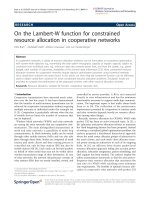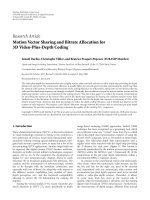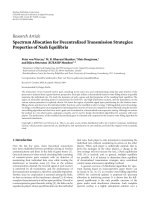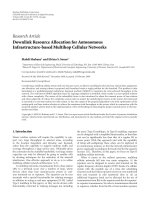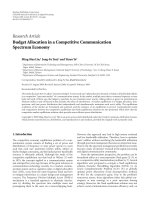Optimal computing budget allocation for constrained optimization
Bạn đang xem bản rút gọn của tài liệu. Xem và tải ngay bản đầy đủ của tài liệu tại đây (1.34 MB, 138 trang )
OPTIMAL COMPUTING BUDGET ALLOCATION FOR
CONSTRAINED OPTIMIZATION
NUGROHO ARTADI PUJOWIDIANTO
NATIONAL UNIVERSITY OF SINGAPORE
2012
OPTIMAL COMPUTING BUDGET ALLOCATION FOR
CONSTRAINED OPTIMIZATION
NUGROHO ARTADI PUJOWIDIANTO
(B. Eng. (Hons.), NTU)
A THESIS SUBMITTED
FOR THE DEGREE OF DOCTOR OF PHILOSOPHY
DEPARTMENT OF INDUSTRIAL AND SYSTEMS ENGINEERING
NATIONAL UNIVERSITY OF SINGAPORE
2012
DECLARATION
I hereby declare that this thesis is my original work and it has
been written by me in its entirety. I have duly
acknowledged all the sources of information which have
been used in the thesis.
This thesis has also not been submitted for any degree in any
university previously.
______________________
Nugroho Artadi Pujowidianto
3 February 2013
i
Acknowledgments
I would like to thank my supervisors, Dr. Yap Chee Meng and Associate Professor
Lee Loo Hay for their patient guidance throughout the research journey. In addition, I
am grateful for the advices given by Professor Chen Chun-Hung and Associate
Professor Raghu Pasupathy. I would also like to thank my Oral Qualifying Examiners,
Associate Professor Chew Ek Peng and Associate Professor Ng Szu Hui for their
valuable comments and suggestions during the proposal of the thesis. I am grateful to
my Oral Defence committee members, Dr. Michel-Alexandre Cardin, Associate
Professor Ng Szu Hui, Associate Professor Ng Kien Ming, and the External Examiner.
I also appreciate the support given by Professor Tang Loon Ching and Associate
Professor Poh Kim Leng and other faculty members of the Department of Industrial
and Systems Engineering (ISE).
My gratitude also goes towards my co-authors, Dr. Susan R. Hunter and Mr. Li
Lingwei. The journey of the research has been made manageable by the Maritime
Logistics and Supply Chain Research groups where I learned a lot from fellow
students especially from those working on simulation optimization, Li Juxin, Zhang Si,
Xiao Hui, and Hu Xiang. I would also thank my Indonesian seniors, Dr. Budi Hartono,
Dr. Nur Aini Masruroh, Dr. Markus Hartono, Dr. Hendry Rahardjo, Dr. Aldy
Gunawan for their guidance when they were working their doctorates. I am heavily
ISE Department particularly Ms Ow Lai Chun, Mdm. Tan Swee Lan, Mr. Lau Pak
Kai, and Ms Celine Neo who have supported me in throughout my study in ISE. The
seminars provided by both ISE Department and the Department of Decision Sciences
ii
have significantly opened my eyes for high quality research around the world. It has
been a great opportunity to experience the hospital settings, thanks to Singapore
Teow Kiok Liang, and Dr. Samuel Ng who provide the opportunity to observe the
radiology process in ParkwayHealth. I have been blessed by the great support from
many friends such as Pr. Budianto Lim, Dr. Linda Bubod, Mr. Eugene Chong, Yopie
Adrianto, Lim Lung Sen, Jefry Tedjokusumo, Dr. Jin Dayu, Nguyen Viet Anh, Freddy
Wilyanto Suwandi, Dr. Albertus H. Adiwahono, Stephanie Budiman, Lee Jiun Horng,
Felixen M. Wirahadisurya, and many more. I am also thankful for the Ministry of
Education staffs and Pioneer Secondary School staffs for their support while I was
finishing the thesis on part-time basis.
I would like to thank my family for their continuous support. The education given
Irma Pujowidiyanto and her husband, Surya Lesmana, together with their love are
invaluable. I am also deeply grateful to my girlfriend, Feliz Adrianne and her family
for their understanding and unwavering encouragement. There are many times when I
felt like quitti
inspiring encouragement, and her love that kept me going. Finally, I would like to
thank God who has given me the strength to complete my thesis. The presence of so
many supporting people in my life is the evidence of His continuous grace which
makes all things possible.
iii
Table of Contents
Acknowledgments i
Table of Contents iii
Summary vii
List of Tables viii
List of Figures x
List of Symbols xi
List of Abbreviations xiii
Chapter 1. Introduction 1
1.1. Background 1
1.2. Motivation 3
1.3. Objective 5
1.4. Scope 5
1.5. Contribution 5
1.6. Organization of the Thesis 7
Chapter 2. Literature Review 8
2.1. Simulation Optimization 8
2.2. Stochastic Constrained Optimization via Simulation 12
2.3. Ranking and Selection 13
2.4. Constrained R&S 15
2.5. Optimal Computing Budget Allocation (OCBA) 16
iv
2.6. Summary of the Research Gaps 17
Chapter 3. Asymptotic Simulation Budget Allocation 18
3.1. Overview 18
3.2. Stochastic Constrained Optimization via Simulation 19
3.3. Computing Budget Allocation 20
3.4. Assumptions 21
3.5. The Problem Formulation using Bonferroni-bound 23
3.6. Proposed Allocation 25
3.6.2. Exact Solution 27
3.6.3. Insights from the Allocation 28
3.6.4. Closed-form Solution 29
3.7. Sequential Allocation Procedure 30
3.8. Numerical Experiments 32
3.8.1. Computing Budget Allocation Procedures 32
3.8.2. Simulation Settings 33
3.8.3. Experimental Results 34
3.9. The Effect of Correlation in Allocating Simulation Budget 38
Chapter 4. Explicit Consideration of Correlation Between Performance Measures in
Simulation Budget Allocation 39
4.1. The Problem Formulation using Large-Deviations Theory 39
4.2. Exact Solution 43
v
4.3. Closed-Form Expressions 45
4.3.1. Properties of the Rate Functions 45
4.3.2. Properties of the Optimal Allocation 48
4.3.3. Closed-Form Approximation 49
4.3.4. Closed-Form Allocation to the Non-best Designs 54
4.4. Score Functions for Multivariate Normal Distribution 56
4.4.1. Score Functions when the Performance Measures are Independent to
Each Other 57
4.4.2. Score Functions in the Case of Correlated Performance Measures 60
4.5. Allocation to the Best Feasible Design 63
4.6. Numerical Examples 67
4.6.1. Convergence Rate Analysis 68
4.6.2. Finite-Time Performance 71
Chapter 5. Bed Allocation Problem 73
5.1. Motivation 73
5.2. System Description and Modeling 77
5.3. Problem Description 79
5.4. Efficient Procedure for Selecting the Best Feasible Bed Alternative 81
5.5. Computational Results and Analysis 83
5.5.1. Selection from a small number of alternatives 83
5.5.2. Selection from a large number of alternatives 89
vi
Chapter 6. Conclusions and Future Research 92
References 96
Appendix A. Proof of Lemma 3.2 110
Appendix B. Proof of Theorem 3.1 112
Appendix C. The KKT conditions for problem (4.11) 115
Appendix D. Finding The Solutions for (4.11) 116
Appendix E. Proof of Lemma 4.1 118
Appendix F. The KKT conditions for problem (4.48) 120
Appendix G. Proof of Theorem 4.4 121
Appendix H. Proof of Theorem 4.5 122
vii
Summary
We consider the constrained optimization problem from a finite set of designs
where their main objective and the constraint measures must be estimated via
stochastic simulation. As simulation is time-consuming, the simulation budget needs to
be efficiently allocated. This thesis proposes two procedures for determining the
number of simulation replications for each design to maximize the probability of
correct selection given a fixed computing budget. The first procedure asymptotically
maximizes the lower bound of the probability of correct selection. The approximation
is based on Bonferroni bounds which are applicable for the cases with independent and
correlated performance measures. The second proposed procedure utilizes large
deviations theory to derive an asymptotically optimal allocation which is able to
explicitly account for the impact of the correlation among the multiple performance
measures. As the number of the designs becomes large, the optimal allocation can be
approximated by closed-form expressions which are simple and easy-to-implement.
The numerical results show that the proposed procedures can enhance the simulation
efficiency. An application example of the proposed procedure to a hospital bed
allocation problem is also provided. The objective is to maximize the bed utilization
while satisfying the maximum limits of turn-around-time and overflow occurrence.
Nested Partitions method is integrated to consider more alternatives.
viii
List of Tables
Table 3.1: Problem Scenarios and Results Given One Stochastic Constraint 37
Table 3.2: Problem Scenarios and Results Given Two Stochastic Constraints 38
Table 4.1: The rate of P{FS} represented by z(α) and computational time under
different number of designs (k) 70
Table 4.2: The rate of P{FS} represented by z(α) and computational time under
different number of constraints (s) 71
Table 4.3: The computing budget (T) to reach 95% P{CS} in the independent case
under different number of designs (k) 72
Table 5.1: Singapore Population Size by Residential Status (Singapore Department of
Statistics, 2011) 74
Table 5.2: Number of Beds in Singapore Hospitals (Singapore Ministry of Health,
2012) 74
Table 5.3: Overflow protocol 78
Table 5.4: The arrival rates for each time period 84
Table 5.5: The simulation parameters for each specialty 84
Table 5.6: The original number of beds 85
Table 5.7: The 5 considered alternatives for bed allocation 85
Table 5.8: The performance measures for each pre-determined configuration 87
Table 5.9: Comparison of EA and OCBA-CO for the scenario with pre-determined
configurations 87
Table 5.10: Proportion of simulation budget allocated to each alternative when γ
2
=15%
87
Table 5.11: The randomly-generated configurations 88
ix
Table 5.12: The performance measures for each randomly-generated configuration 88
Table 5.13: Comparison of EA and OCBA-CO when the configurations are randomly
generated 88
Table 5.14: Effect of TAT limit when the overflow limit is 50% 90
Table 5.15: Effect of Overflow limit when the TAT limit is 480 minutes 90
x
List of Figures
Figure 3.1: P{CS} versus T for Scenarios 3 and 8 38
Figure 4.1: Illustration of Problem Scenario 69
Figure 4.2: P{FS} vs. T when s=1, ρ=0 in the scenarios with k=26 and k=101 72
Figure 5.1: Population and Admission based on Age 75
Figure 5.2: Process Flow 78
Figure 5.3: The Framework for Integrating OCBA-CO and Nested Partitions 82
Figure 5.4: Convergence of NP+OCBA-CO in terms of main objective value 90
xi
List of Symbols
The following are some selected notations,
= number of designs,
= index for designs, ,
= number of stochastic constraints,
= index for the performance measures, for the main objective while
for the constraint measures,
= random variable for the main objective for design ,
= mean of the main objective for design ,
= sample mean of the main objective for design ,
= variance of the main objective for design ,
= random variable for the th constraint measure for design ,
= mean of the th constraint measure for design ,
= sample mean of the th constraint measure for design ,
= variance of the th constraint measure for design ,
= the th constraint limit,
= number of simulation replications for design ,
= total computing budget,
= proportion of the simulation budget allocated to design , i.e.
,
= the covariance matrix of design ,
= the correlation coefficient between any two random variables
and
,
= probability of correct selection,
= approximate term for the probability of correct selection,
xii
= the desired level of
= probability of false selection,
= the difference between the best and non-best design in terms of main
objective value,
= the difference between the th constraint measure of design to the
respective constraint limit,
= the most critical constraint measure of design ,
= the noise-to-signal ratio of design ,
= number of feasible designs,
= initial number of replications,
= increment,
= rate function of design ,
= rate function of the probability of the non-best design being better than
the best design,
= the score function of design ,
= the rate of approaching zero for a given set of .
xiii
List of Abbreviations
AK+ = The procedure by Andradóttir and Kim (2010),
CS = Correct Selection,
EA = Equal Allocation,
FS = False Selection,
IZ = Indifference Zone,
NP = Nested Partitions,
OCBA = Optimal Computing Budget Allocation,
OCBA-CO = Optimal Computing Budget Allocation for Constrained Optimization,
= Probability of Correct Selection,
= Probability of False Selection,
R&S = Ranking and Selection.
1
Chapter 1. Introduction
1.1. Background
The importance of optimization is increasing in many industries as the
globalization requires most institutions to be more competitive. Optimization can be
defined as the process of making the best use of resources to maximize the rewards
based on the desired result. It involves specifying the performance measures which are
important for the institutions and knowing the set of factors or decision variables
which can be controlled. In addition, the uncontrollable factors which influence the
objective must be acknowledged. Trying different alternatives may be costly and thus
we focus on the optimization by building a mathematical model to obtain the best
alternative.
Optimization becomes even more challenging when the performance measures are
stochastic. The term stochastic means random or non-deterministic. This is not
uncommon as many factors in the real world are uncertain. The evaluation of the
performance measures need to take into account of the randomness. One common way
is to use simulation which basically aims to imitate the real-world settings. Amongst
the many kinds of simulations, the term simulation in this thesis refers to the
computer-based simulation, specifically stochastic simulation. A stochastic simulation
enables us to evaluate a set of realizations of the random factors.
Due to the complexities of the real-world setting, analytical expressions of the
performance measures are often not available. For example, it is difficult to evaluate
the waiting time of customers which is dependent on that of the previous customers.
Thus, we focus on the stochastic discrete-event simulation. The use of discrete-event
2
simulation allows the modeling of complex problems as it is able to capture the
dynamic relationships between the entities involved and the uncertainties inherent in
the problem. Fu (2002) states that discrete-event simulation is the primary domain in
optimization of stochastic simulation. An optimization where the performance
measures are evaluated via simulation is called as optimization via simulation or
simulation optimization.
Although simulation can analyze and evaluate complex systems for which closed-
form analytical expressions are not available, it is computationally intensive as
multiple simulation replications are required to evaluate each design. For example,
increasing the accuracy of the estimated value by ten times would commonly require a
hundred times of simulation replications. Although the advancement of technology and
computers has made simulation faster, computing budget is often still limited. For
instance, according to the study by Gu as cited in Simpson et al. (2004), it takes Ford
Motor Company 36 to 160 hours just to simulate one crash simulation on a full
passenger car. Thus, the simulation budget needs to be efficiently allocated.
In this thesis, we consider the problem of selecting the best feasible design from a
fixed set of alternatives or designs. As the number of designs is finite, all designs are
simulated and the focus is the statistical inference comparison where ranking and
selection procedures are applicable (Fu et al. 2005).
The presence of constraints increases the difficulties in a ranking and selection
problem. In many real world problems, the decision maker needs to optimize the main
objective while also satisfying the constraints. This is not uncommon as there are many
constraints which are either set internally or imposed by external authorities in
achieving the optimal results. The constraints can be in terms of the decision variables
or in terms of other secondary performance measures referred as the constraint
3
measures. The consideration of the latter is more difficult when the constraint
measures are also stochastic. For example, a decision maker in a hospital may want to
maximize bed utilization while satisfying the service criteria such as the patients
waiting time and number of overflow. Both the utilization and service criteria depend
on some realizations of the randomness. In this case, the computing budget
requirement becomes higher as there are multiple performance measures. We need to
ensure that the number of replications is sufficient to avoid false selection due to either
feasibility or optimality. A ranking and selection problem with stochastic constraints is
called constrained ranking and selection (Kim and Nelson, 2007).
This thesis attempts to study the problem of finding the most efficient way in
allocating the simulation samples for selecting the best feasible design from a fixed set
of designs in the presence of stochastic constraints. The best design is selected based
on a primary performance measure or main objective from the feasible designs. The
feasible designs are the designs of which secondary performance measures or
constraint measures satisfy the respective constraint limits. The values of the main
objective and constraint measures considered are not available directly and are thus
estimated using simulation.
1.2. Motivation
This current study is motivated by the fact that there are some research
opportunities in the constrained ranking and selection (R&S) as fully elaborated in
Chapter 2. Although simulation optimization and ranking and selection have been
widely studied, there is relatively less development in the case with stochastic
constraints (Andradóttir and Kim 2010). This is due to the difficulties in considering
4
the randomness of each of the performance measures. In addition, optimization with
multiple performance measures is difficult by nature due to the trade-offs between
them.
As the computing budget is limited, there is still a need to develop a more efficient
procedure for the constrained R&S. This is important as simulation optimization still
needs a considerable amount of computational efforts (Fu et al. 2008). The existing
works on the constrained R&S focus more on guaranteeing probability of correct
selection (). There is another branch of R&S which aims to maximize
given a fixed computing budget called as Optimal Computing Budget Allocation
(OCBA). Although OCBA has been shown to be effective for the unconstrained
optimization (Branke et al. 2007), none of the research has incorporated the notion of
OCBA for constrained optimization. This motivates research in extending OCBA for
handling the presence of stochastic constraints. As there are multiple constraint
measures and they are often correlated, there is also a need to study the effect of
correlation to the simulation budget allocation. As some of the real world problems
currently could not incorporate the notion of simulation due to the presence of
constraints, we want to apply our proposed procedure to a real world setting, in
particular to a hospital bed allocation problem. This would complement the few
literatures on the healthcare which use simulation optimization. One of the common
applications of discrete-event simulation is in the area of healthcare. In particular, it is
often used to build operational models of healthcare units (Brailsford 2007). However,
there are few literatures which consider random constraints or use simulation
optimization for dealing with the healthcare problems.
5
1.3. Objective
The purpose of this thesis is to enhance simulation efficiency by intelligently
controlling the number of simulation replications so that the probability of correctly
selecting the best feasible design within a fixed computing budget can be maximized.
Specifically, we aim to derive simulation budget allocation rules which are easy to
implement. In addition, we want to demonstrate how the proposed procedure can be
applied to address the real-world problems by providing an example on the problem of
determining the optimal number of hospital beds.
1.4. Scope
We focus on the black-box simulation optimization from a finite set of designs.
We focus on the ranking and selection procedure in addressing the problem instead of
other the gradient-based methods as the decision variables are discrete. In addition, the
selection of the best feasible design is based on the sample mean of the performance
measure of interest. We do not discuss the consideration of parallel computing or cloud
computing method in reducing the computational requirement as the results of this
research can be applied both in a single computer or a set of parallel computers.
1.5. Contribution
There are several contributions made in this thesis as follows:
From the ranking and selection perspective, we extend the OCBA approach to
address the constrained R&S problem in the presence of multiple stochastic
constraints. OCBA aims to maximize and it has been shown to be effective
6
for the unconstrained optimization. As the presence of constraints changes the
definition of the critical designs, a direct application of OCBA may not be
efficient and so an extension is needed.
In addition, we characterize the effect of correlation to the computing budget
allocation and provide the framework for extending the result for the general
distribution case.
-form allocation rule that
is easy to implement and insightful. This is essential to the practitioners who may
not want to spend significantly more time or efforts to compute the allocation for
each design.
For users who are more concerned on the optimality, the procedures can also
return optimal allocation using a solver.
We generalize the OCBA for selecting the best design. The proposed procedures
show that when all of the designs are feasible, the allocation rules are the same as
the OCBA for unconstrained optimization.
We provide the proof that as the number of designs becomes large, the optimal
allocation can be approximated by closed-form expressions. In addition, the proof
is applicable for the unconstrained optimization. Furthermore, although we do not
provide the allocation rule, the proof is also applicable for the case with general
distribution instead of only multivariate normal distribution.
From the health service research perspective, we add the case of an application of
simulation optimization to the bed allocation problem. The framework used in this
thesis can also be applied to other healthcare problems such as the scheduling
problems for operating theater, staffs, or outpatient appointment.
7
1.6. Organization of the Thesis
The organization of this thesis is as follows. Chapter 2 reviews the related works
while chapter 3 formulates the problem of optimally computing budget allocation for
constrained optimization and provides the solution based on Bonferroni bounds.
Chapter 4 proposes an extension using large deviations theory to develop the optimal
allocation framework which is able to explicitly account for the presence of correlation
between the performance measures. An application of the proposed simulation budget
allocation rule to the bed allocation problem is presented in chapter 5. Chapter 6
concludes the thesis.
8
Chapter 2. Literature Review
In this chapter, existing literatures relevant to the stochastic constrained
optimization via simulation and its application are reviewed. Section 2.1 provides a
brief literature review on past studies pertaining to simulation optimization. Section
2.2 specifically reviews the relatively fewer developments on the works addressing
simulation optimization problems with stochastic constraints. Section 2.3 elaborates
the Ranking and Selection (R&S) procedures which are applicable given a fixed set of
alternatives. This is followed by the specific discussion on the constrained R&S
procedures in section 2.4. Section 2.5 highlights the development of Optimal
Computing Budget Allocation (OCBA), a R&S framework which aims to maximize
the probability of correct selection. Section 2.6 summarizes the research gaps which
motivate this thesis.
2.1. Simulation Optimization
Simulation optimization is the process of finding the best design where the
performance measures need to be evaluated via stochastic simulation. It is also
commonly called optimization via simulation (OvS). As a branch of stochastic
optimization, it considers the randomness which influences the performance measures.
This should be distinguished from stochastic programming. In stochastic
programming, only the randomness needs to be simulated. In other words, there is a
closed-form expression for the performance measure. One approach for stochastic
programming is Sample Average Approximation (SAA) or sample path optimization
9
(Rubinstein and Shapiro, 1993; Homem-de-Mello et al., 1999; Kleywegtet al., 2001).
Fu (2002) called this approach as simulation for optimization as for a given realization
of the randomness using a scenario generator, the tools for deterministic optimization
can be used. On the other hand, simulation optimization can be considered as
optimization for simulation. This is because for each design, the performance measures
are not available analytically and have to be evaluated via simulation. This is often
done using commercial simulation software. An optimization subroutine then is added
to find the best design. The type of simulation used is usually discrete-event simulation
which is able to incorporate uncertainties and the dynamic relationships within the
considered system.
In general, simulation optimization can be classified into three groups (Hong and
Nelson, 1999). The first group is ranking and selection which deals with the problem
where the number of alternatives is fixed and all are simulated. This will be further
described in section 2.4. The other groups deal with the case with a huge or even an
infinite number of alternatives. Based on the type of decision variables, these
optimization via simulation methods can be divided into two groups. The methods
depend on whether they have continuous or discrete decision variables (Tekin and
Sabuncuoglu 2004). Thus, the second and third groups are continuous simulation
optimization and discrete simulation optimization. The details of the different
procedures can be found in the excellent reviews by Swisher et al. (2003), Tekin and
Sabuncuoglu (2004), Fu et al. (2008). A library of simulation optimization problems
can be found in Pasupathy and Henderson (2006, 2010).
The literature on continuous simulation optimization can be traced back to the
stochastic approximation (SA) works by Robbins and Monro (1951) and Kiefer and
Wolfowitz (1952). The extended version of SA can be found in Kushner and Yin




